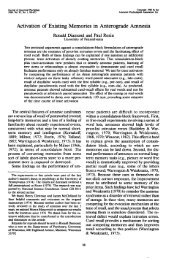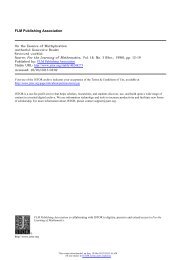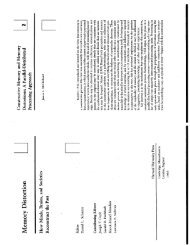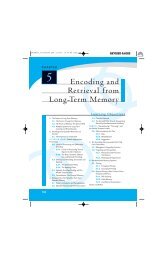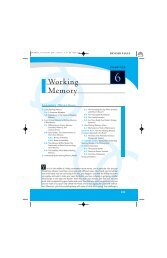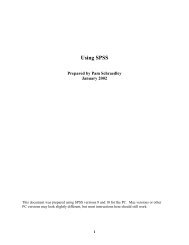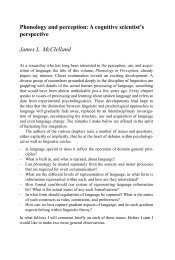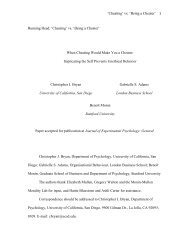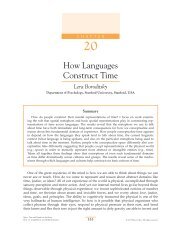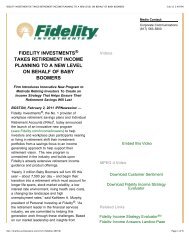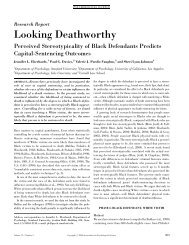Embodied and disembodied cognition: Spatial perspective-taking
Embodied and disembodied cognition: Spatial perspective-taking
Embodied and disembodied cognition: Spatial perspective-taking
You also want an ePaper? Increase the reach of your titles
YUMPU automatically turns print PDFs into web optimized ePapers that Google loves.
versation is only one example of a social situation that<br />
encourages <strong>perspective</strong>-<strong>taking</strong>. Another situation is interaction<br />
of bodies rather than voices. Even simple social<br />
interactions, such as accepting a cup of coffee from someone<br />
or negotiating the crowd on the street, require anticipating<br />
the actions of others in order to coordinate our<br />
own. Anticipating others’ actions may also help to underst<strong>and</strong><br />
those actions even without the intent or immediate<br />
need to respond. Watching a tennis serve, observing how<br />
to buy a train ticket in a foreign country, studying an effective<br />
public speaker are examples. Taking the <strong>perspective</strong> of<br />
the other may be effective both for planning responses to<br />
others’ actions <strong>and</strong> for underst<strong>and</strong>ing <strong>and</strong> learning them.<br />
Thus, it is possible that simply seeing another person in a<br />
scene near objects in grasping range will elicit some spontaneous<br />
<strong>perspective</strong>-<strong>taking</strong>.<br />
Would the mere presence of another in a scene with the<br />
potential for action elicit <strong>taking</strong> that person’s <strong>perspective</strong>,<br />
without any dem<strong>and</strong> to communicate to that person? This<br />
is the first question addressed here, in a simple, direct task.<br />
A questionnaire included a photograph of a bottle <strong>and</strong> a<br />
book on a table, with or without a person behind the table<br />
(see Fig. 1), below which was a question: In relation to the<br />
bottle, where is the book? Would participants respond<br />
using their own right <strong>and</strong> left, or use right <strong>and</strong> left with respect<br />
to the other’s <strong>perspective</strong>? The expectation was that<br />
the presence of another person in the scene, especially one<br />
related to <strong>and</strong> likely to use the objects whose spatial relations<br />
are queried, would induce some participants to take<br />
the other person’s <strong>perspective</strong> rather than their own.<br />
If <strong>perspective</strong>-<strong>taking</strong> is related to underst<strong>and</strong>ing or anticipating<br />
another’s actions, then calling attention to action by<br />
phrasing a question about the spatial relations between the<br />
objects in terms of action should increase <strong>perspective</strong>-<strong>taking</strong>.<br />
Thus a second study compared static questions like that<br />
of the first experiment to action questions.<br />
2. Study 1: mere presence of another elicits spatial<br />
<strong>perspective</strong>-<strong>taking</strong><br />
Does the mere presence of a person in a scene with two<br />
salient objects placed on a table near the person cause<br />
some respondents to spontaneously take the spatial <strong>perspective</strong><br />
of the other person rather than their own?<br />
2.1. Method<br />
One hundred Stanford <strong>and</strong> 90 University of Oregon<br />
undergraduates were presented with one of the three pho-<br />
Author's personal copy<br />
B. Tversky, B.M. Hard / Cognition 110 (2009) 124–129 125<br />
Fig. 1. Scenes used in Studies 1 <strong>and</strong> 2. Participants in Study 1 were shown one of the three scenes, depending on condition: reaching scene (a), looking scene<br />
(b), or no person scene (c). Participants in Study 2 were shown only the scene of an actor reaching for an object (a).<br />
tographs in Fig. 1 <strong>and</strong> asked: ‘‘In relation to the bottle,<br />
where is the book?” The no person (n = 64) photograph<br />
showed a bottle <strong>and</strong> a book on a table. Two other photographs<br />
included a person sitting behind the table, either<br />
looking (n = 64) at the book or reaching (n = 62) for it. In both<br />
studies, the photograph <strong>and</strong> question were part of a large<br />
set of unrelated questionnaires students completed for<br />
course credit, at Stanford, a paper booklet, <strong>and</strong> at University<br />
of Oregon, online. There were no differences between Stanford<br />
<strong>and</strong> University of Oregon undergraduates in any of the<br />
results in either study so the results were combined.<br />
2.2. Results<br />
The responses were scored as self <strong>perspective</strong> if the answer<br />
provided was from the viewer’s viewpoint, other if<br />
the answer was from the person in the scene’s viewpoint,<br />
<strong>and</strong> neutral if the answer gave spatial information from<br />
neither <strong>perspective</strong>, for example, ‘‘next to.” Examples of responses<br />
scored as self include: ‘‘right,” ‘‘on the right,”<br />
‘‘about a foot to the right,” ‘‘to the right of the bottle from<br />
my <strong>perspective</strong>.” Examples scored as ‘‘other” include:<br />
‘‘left,” ‘‘to his left,” ‘‘to the left according to the way he is<br />
facing,” ‘‘to the left (relative to his <strong>perspective</strong>).” Four participants<br />
(one other <strong>perspective</strong> <strong>and</strong> 3 self <strong>perspective</strong>)<br />
used both <strong>perspective</strong>s in their response, writing, for<br />
example, ‘‘my right, his left.” In those cases, the first <strong>perspective</strong><br />
mentioned determined the coding category.<br />
Examples scored as neutral include: ‘‘across the table,”<br />
‘‘to the side,” ‘‘parallel,” ‘‘a foot away.” In describing spatial<br />
relations, people often avoid using left <strong>and</strong> right (e.g., Mainwaring<br />
et al., 2003) because these terms are more difficult<br />
than other spatial relation terms, like front, across, or near<br />
(e.g., Franklin & Tversky, 1990).<br />
Scored responses were converted into two binary variables<br />
for analysis: one variable was coded 1 if the response<br />
was self <strong>perspective</strong> <strong>and</strong> 0 if it was not; the second variable<br />
was coded 1 if the response was other <strong>perspective</strong> <strong>and</strong> 0 if<br />
it was not. These variables were each analyzed with a oneway<br />
Analysis of Variance, followed by two planned contrasts:<br />
one comparing the no person photograph to the<br />
photographs depicting a person (looking <strong>and</strong> reaching)<br />
<strong>and</strong> another comparing the looking to the reaching photograph.<br />
For all analyses, the criterion for significance was alpha<br />
level less than .05. We report partial eta squared (g 2 p )<br />
as an estimate of effect size for significant ANOVA effects,<br />
<strong>and</strong> Cohen’s d for significant t-test effects.<br />
The photograph viewed affected the frequency of other<br />
<strong>perspective</strong>, F(2,187) = 8.26, p < .05, g 2 = .08. As evident



